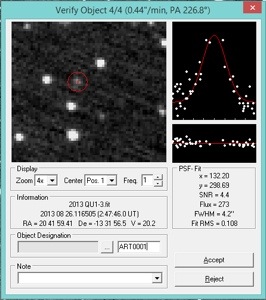Did you know that there is a giant belt of Asteroids in our Solar System? It’s called the Kuipers belt and sits past Neptune up to a distance of 50x of the distance between Earth and the Sun (called AU or Astronomical Units).
Then, there is one even closer, the so called Main Asteroid Belt, which sits right in between Mars and Jupiter. That’s where our ‘almost discovery’ originated from – but more of that later.
Even further out, outside of our Solar System, but well inside our Galaxy is a whole cloud of whirling Asteroids – the Oort cloud.
Once in a while, we get a visitor from these distant places.
Most of them pass in safe distance of the Earth and if they are composed of the right material – frozen methane, ammonia and other volatile substances – its even a spectacular view: A Comet.
But we need to keep track of those floating rocks because occasionally one of these things comes crashing on our marvelous blue dot – a Meteorite.
In my never ending quest for knowledge, I participated in a challenge called out by the Space Generation Advisory Council (SGAC) and the International Astronomical Search Collaboration (IASC).
They asked that teams to be formed and search or track Asteroids and Near Earth Objects (NEO).
Challenge accepted!
After forming a team with Spacetweeps all over the world, we soon realized this is not as easy as it seems, because none of us had only the remotest idea on how one identifies those heavenly bodies from the data provided.
Fortunately enough we found someone skilled and passionate to help us getting started.
The method for identification is called Astrometric and what it does is basically taking a couple of long term exposures of a certain region of the sky some hours apart and then comparing those pictures with a tool and your eyes if anything is moving differently than the rotation of earth.
Tricky in itself because often enough, planes crossed the field of view and made discovering that tiny little dots moving just some millimeters difficult to spot.
Living in the computer age, we had help by some algorithms of a tool appropriately called Astrometrica. But one has still to distinguish between noise, errors and real moving objects.
Each discovery is an awesome thing. Imagine, you have just identified an object zipping through the void of Space probably from a time when our solar System and Planets formed.
Most of the times, these discoveries where known objects, where we reported the trajectory and coordinates back to the minor planetary center to enhance their database and confirm or refine the data stored for this object.
Sometimes while carefully watching the blinking pictures an unknown object appeared and was marked by the team. Again, most of them were later categorized as noise or an already known object.
But one of our finds was reported back as a preliminary find of a new object. We were stoked and jumped like kiddos on the parents new couch. I mean we found a tiny blob on the pictures taken just some days ago and saw a potential Asteroid, no one had seen before! I guess that’s justification enough 🙂
In the end, the find wasn’t confirmed, because it has to be rediscovered within a certain time to qualify as a real find. And if lucky enough, a find can then be named by the discoverer.
So what is the take away of our challenge? First of all there is the confidence that we helped the scientific community to track potentially hazardous objects and better calculate their orbits. And then there is that satisfying feeling that I have broadened my knowledge and participated in a fun STEM activity with international friends.
Now, what next?






